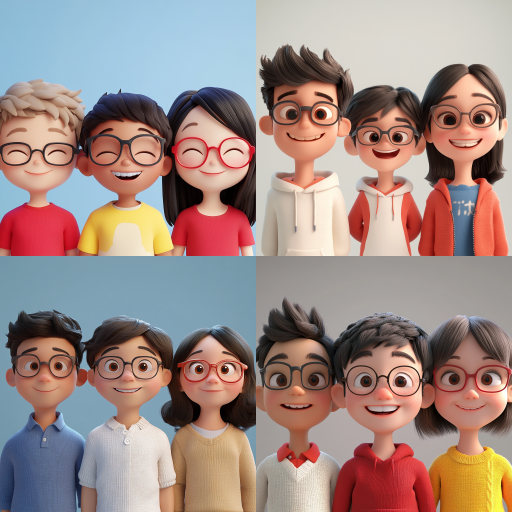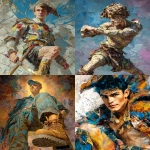Explore the Best AI Image Gallery

Wearable Tech Innovations: Transforming Creativity and Beyond
In an age where technology permeates every facet of our lives, wearable tech has emerged at the forefront of innovation. From smartwatches to augmented reality glasses, these devices are not only enhancing day-to-day tasks but are also reshaping creative industries. Artists, designers, and marketers are embracing this technology to elevate their work, giving rise to an exciting intersection of creativity and innovation.
The Impact on the Creative Industry
Wearable technology has brought a wave of transformation in the creative industry by enabling new forms of interactive and immersive experiences. For instance, artists are utilizing virtual reality (VR) headsets to create 3D installations that captivate viewers in ways traditional art cannot. This tech allows audiences to engage with art on a deeper level, offering unique perspectives and interpretations, which can foster greater emotional connections.
Similarly, fashion designers are experimenting with wearables that incorporate electronic elements into textiles. These innovations can change color, adapt to environmental cues, or even display digital images. One notable example is the collaboration between tech companies and fashion brands to create clothing that reacts to the wearer’s surroundings, creating a blend of functionality and artistic expression. This melding of tech and fashion opens up endless possibilities for conceptual design and storytelling through wearable art.
Potential Uses of Wearable Technology
Beyond the realms of art and fashion, wearable tech is finding applications across various creative sectors. Here are a few notable areas where wearables are making their mark:
- Digital Fashion Shows: Designers are replicating traditional fashion shows through VR, allowing a global audience to experience their latest collections from the comfort of their homes.
- Interactive Exhibitions: Museums and galleries are incorporating AR-enabled wearables to provide informative tours, allowing patrons to learn more about artworks interactively.
- Creative Writing: Wearables that track emotional and physiological responses can inform writers, enabling them to craft narratives that resonate more deeply with readers.
- Fitness and Performance Art: Dancers and performers are utilizing wearables to monitor their movements, which can enhance choreography and overall performance quality.
Ethical Considerations
As with any technological advancement, wearables raise ethical questions that need to be addressed. One primary concern is data privacy. Many devices collect sensitive information about users, from health metrics to location tracking. This data can be invaluable for artists and marketers, but its collection and usage must be transparent and consensual to protect user privacy. Additionally, the potential for data misuse or breaches ignites conversations around corporate responsibility and consumer rights.
Moreover, the intersection of design and technology can lead to issues of accessibility. Not all individuals have equal access to the financial resources required for cutting-edge wearables, which can inadvertently widen the gap between different societal groups. Ensuring that wearable technology is inclusive and available to diverse populations remains a critical challenge in this innovative landscape.
The Future of Wearable Technology
The future of wearable technology in the creative industry looks promising, with exciting trends on the horizon:
- Streamlined Integration: As technology advances, we can expect more seamless integration of wearable tech in everyday life. Devices will likely become more fashionable and less obtrusive, making them a staple in both personal and professional environments.
- Enhanced Collaboration: Creatives may find it increasingly easy to collaborate using wearables that allow for real-time data sharing and communication, benefiting fields like design and production.
- Personalization: The rise of AI will make wearables more attuned to individual user preferences and behaviors, creating a personalized experience that can significantly influence creative workflows.
- Telepresence in Creative Collaboration: With advancements in VR and AR, we might see a surge in remote collaboration, where artists can create together virtually, regardless of geographical locations.
Conclusion
Wearable technology is undeniably transforming the creative landscape. As artists and designers harness its potential, they are not merely adopting a tool but embracing an entire paradigm shift in how creativity can be expressed and experienced. The implications of this shift extend beyond aesthetics and functionality—it will challenge norms, push boundaries, and spark ethical discussions about the future we are creating. Ultimately, wearable tech is set to uplift creativity in ways we are just beginning to comprehend, ushering in an era of limitless possibilities in the arts and beyond.



](https://images.ai-img.art/thumbnails/150/8c3bd422d50d35735d8fb33bd314a79e30e5b150129d5d09bdad822a2007593f.webp)
](https://images.ai-img.art/thumbnails/150/3a60737a5b67fa252207ad1ae6db245a26284f53fb5846996bb34515b39ff269.webp)



](https://images.ai-img.art/thumbnails/150/1614d64dd7156c95db952258978be809eb3db8cea4453fec69c49cbdfe63fa94.webp)



